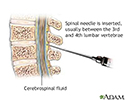Radionuclide cisternogram
CSF flow scan; Cisternogram
A radionuclide cisternogram is a nuclear scan test. It is used to diagnose problems with the flow of spinal fluid.
How the Test is Performed
A spinal tap (lumbar puncture) is done first. Small amounts of radioactive material, called a radioisotope, are injected into the fluid within the spine. The needle is removed immediately after the injection.
You will then be scanned 1 to 6 hours after getting the injection. A special camera takes images that show how the radioactive materials travel with the cerebrospinal fluid (CSF) through the spine. The images also show if the fluid leaks outside the spine or brain.
You will be scanned again 24 hours after injection. You may need additional scans possibly at 48 and 72 hours after injection.
How to Prepare for the Test
Most of the time, you do not need to prepare for this test. Your health care provider may give you medicine to calm your nerves if you are very anxious. You will sign a consent form before the test.
You will wear a hospital gown during the scan so your doctors have access to your spine. You will also need to remove jewelry or metallic objects before the scan.
How the Test will Feel
Numbing medicine will be put on your lower back before the lumbar puncture. However, many people find lumbar puncture somewhat uncomfortable. This is often due to the pressure on the spine when the needle is inserted.
The scan is painless, although the table may be cold or hard. No discomfort is produced by the radioisotope or the scanner.
Why the Test is Performed
The test is performed to detect problems with the flow of spinal fluid and spinal fluid leaks. In some cases, there may be a concern that the CSF fluid is leaking after a trauma to the head or a surgery in the head. This test will be done to diagnose the leak.
Normal Results
A normal value indicates normal circulation of CSF through all parts of the brain and spinal cord.
What Abnormal Results Mean
An abnormal result indicates disorders of CSF circulation. These disorders may include:
- Hydrocephalus or dilated spaces in your brain due to an obstruction
- CSF leak
- Normal pressure hydrocephalus (NPH)
- Whether or not a CSF shunt is open or blocked
Risks
Risks associated with a lumbar puncture include:
- Pain at the injection site
- Bleeding
- Infection
There is also a very rare chance of nerve damage.
The amount of radiation used during the nuclear scan is very small. Almost all of the radiation is gone within a few days. There are no known cases of the radioisotope causing harm to the person getting the scan. However, as with any radiation exposure, caution is advised if you are pregnant or breastfeeding.
In rare cases, a person may have an allergic reaction to the radioisotope used during the scan. This may include a serious anaphylactic reaction.
Considerations
You should lie flat after the lumbar puncture. This can help prevent a headache from the lumbar puncture. No other special care is necessary.
References
Mettler FA, Guiberteau MJ. Central nervous system. In: Mettler FA, Guiberteau MJ, eds. Essentials of Nuclear Medicine Imaging. 3rd ed. Philadelphia, PA: Elsevier; 2019:chap 3.
Swanson JW, Bartleson JD. Cranial and facial pain. In: Jankovic J, Mazziotta JC, Pomeroy SL, Newman NJ, eds. Bradley's and Daroff's Neurology in Clinical Practice. 8th ed. Philadelphia, PA: Elsevier; 2022:chap 20.
Review Date: 7/1/2023









